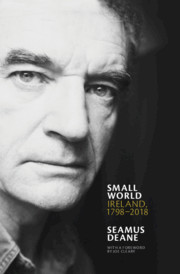28 results
Chapter 16 - The End of the World
-
- Book:
- Small World
- Published online:
- 03 June 2021
- Print publication:
- 27 May 2021, pp 287-330
-
- Chapter
- Export citation
Chapter 5 - Irish National Character 1790–1900
-
- Book:
- Small World
- Published online:
- 03 June 2021
- Print publication:
- 27 May 2021, pp 94-121
-
- Chapter
- Export citation
Contents
-
- Book:
- Small World
- Published online:
- 03 June 2021
- Print publication:
- 27 May 2021, pp vii-viii
-
- Chapter
- Export citation
Chapter 13 - Emergency Aesthetics
-
- Book:
- Small World
- Published online:
- 03 June 2021
- Print publication:
- 27 May 2021, pp 235-254
-
- Chapter
- Export citation
Chapter 11 - Elizabeth Bowen: Two Stories in One
-
- Book:
- Small World
- Published online:
- 03 June 2021
- Print publication:
- 27 May 2021, pp 207-214
-
- Chapter
- Export citation
Chapter 10 - Elizabeth Bowen: Sentenced to Death
-
- Book:
- Small World
- Published online:
- 03 June 2021
- Print publication:
- 27 May 2021, pp 180-206
-
- Chapter
- Export citation
Chapter 1 - Swift as Classic
-
- Book:
- Small World
- Published online:
- 03 June 2021
- Print publication:
- 27 May 2021, pp 1-18
-
- Chapter
- Export citation
Chapter 15 - The Famous Seamus
-
- Book:
- Small World
- Published online:
- 03 June 2021
- Print publication:
- 27 May 2021, pp 270-286
-
- Chapter
- Export citation
Permissions
-
- Book:
- Small World
- Published online:
- 03 June 2021
- Print publication:
- 27 May 2021, pp xxviii-xxix
-
- Chapter
- Export citation
Acknowledgements
-
- Book:
- Small World
- Published online:
- 03 June 2021
- Print publication:
- 27 May 2021, pp xxx-xxx
-
- Chapter
- Export citation
Chapter 9 - Dead Ends: Joyce’s Finest Moments
-
- Book:
- Small World
- Published online:
- 03 June 2021
- Print publication:
- 27 May 2021, pp 162-179
-
- Chapter
- Export citation
Chapter 3 - Tone: The Great Nation and the Evil Empire
-
- Book:
- Small World
- Published online:
- 03 June 2021
- Print publication:
- 27 May 2021, pp 34-73
-
- Chapter
- Export citation

Small World
- Ireland, 1798–2018
-
- Published online:
- 03 June 2021
- Print publication:
- 27 May 2021
Chapter 7 - Heroic Styles: The Tradition of an Idea
-
- Book:
- Small World
- Published online:
- 03 June 2021
- Print publication:
- 27 May 2021, pp 133-148
-
- Chapter
- Export citation
Index
-
- Book:
- Small World
- Published online:
- 03 June 2021
- Print publication:
- 27 May 2021, pp 331-344
-
- Chapter
- Export citation
Copyright page
-
- Book:
- Small World
- Published online:
- 03 June 2021
- Print publication:
- 27 May 2021, pp iv-iv
-
- Chapter
- Export citation
Foreword
-
- Book:
- Small World
- Published online:
- 03 June 2021
- Print publication:
- 27 May 2021, pp ix-xxvii
-
- Chapter
- Export citation
Chapter 12 - Mary Lavin: Celibates
-
- Book:
- Small World
- Published online:
- 03 June 2021
- Print publication:
- 27 May 2021, pp 215-234
-
- Chapter
- Export citation
Chapter 14 - Wherever Green is Read
-
- Book:
- Small World
- Published online:
- 03 June 2021
- Print publication:
- 27 May 2021, pp 255-269
-
- Chapter
- Export citation
Dedication
-
- Book:
- Small World
- Published online:
- 03 June 2021
- Print publication:
- 27 May 2021, pp v-vi
-
- Chapter
- Export citation



